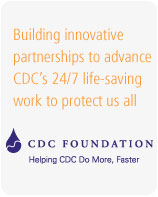CDC and Food Safety: Preventing the Spread of Foodborne Illness
CDC and Food Safety: Preventing the Spread of Foodborne Illness [PDF - 1,154KB]
 Each year, 1 in 6 Americans gets sick from and 3,000 die of foodborne diseases. Reducing foodborne illness by 10% would keep 5 million Americans from getting sick each year. Preventing a single fatal case of Escherichia coli O157:H7 infection would save an estimated $7 million.
Each year, 1 in 6 Americans gets sick from and 3,000 die of foodborne diseases. Reducing foodborne illness by 10% would keep 5 million Americans from getting sick each year. Preventing a single fatal case of Escherichia coli O157:H7 infection would save an estimated $7 million.
Current food safety challenges
Challenges to food safety will continue to arise in unpredictable ways, largely due to:
- Changes in our food production and supply
- Changes in the environment leading to food contamination
- Rising number of multistate outbreaks
- New and emerging germs, toxins, and antibiotic resistance
- New and different contaminated foods, such as prepackaged raw cookie dough, bagged spinach, and peanut butter, causing illness
What is CDC′s role in food safety?
Food safety depends on strong partnerships. CDC and the regulatory agencies (the Food and Drug Administration [FDA] and the US Department of Agriculture′s Food Safety and Inspection Service [FSIS]) play complementary roles in the federal food safety effort. State and local health departments also play critical roles in all aspects of food safety.
CDC provides the vital link between illness in people and the food safety systems of government agencies and food producers. CDC does this by:
- Monitoring human illness — Tracking the occurrence of foodborne diseases
- Defining the public health burden of foodborne illness
- Attributing illness to specific foods and settings
- Investigating outbreaks and sporadic cases — Managing the DNA "fingerprinting" network for foodborne illness–causing germs in all states to detect outbreaks
- Empowering state and local health departments
- Targeting prevention measures to meet long–term food safety goals
- Informing food safety action and policy—The new Food Safety Modernization Act and the egg safety regulation were driven in part by CDC data and investigative findings.
Creative investigating: A food sleuth + a shopper card + a salami = Successful investigation
In 2010, CDC "disease detectives" worked with state and local health authorities to track down the source of a Salmonella foodborne disease outbreak in 2010 that sickened more than 270 persons in more than 40 states. And what clue unlocked the mystery? Something many people have in their wallets or on their key rings—a shopper card that they swipe at the grocery store. After the Washington State Department of Health discovered that many ill people shopped at one grocery store chain, they used shopper card information (with permission) to identify a food that all of the ill people had eaten: salami from one producer. A multistate investigation identified salami coated with pepper as the source, and the salami was recalled. Without violating the shoppers′ privacy, the resourceful use of unconventional data helped CDC and its public health partners across the country more quickly identify the source of the problem and stop the outbreak.
Winnable battles in food safety
- Decrease Salmonella and other food–related infections
- Accelerate the public health response to foodborne illness at the local, national, and global levels
We′re taking action
 Discovery—Tracking trends and risk factors, defining the burden, finding new pathogens and drug resistance, and attributing illness to specific foods
Discovery—Tracking trends and risk factors, defining the burden, finding new pathogens and drug resistance, and attributing illness to specific foods- Innovation—Developing new tools, methods, and analytics in epidemiology, laboratory science, and environmental health
- Implementation—Sharing new technology and information with local, state, and federal partners; improving communications with the public health community, industry, and consumers; and targeting information to guide policy
What′s next
- Centers that are faster at responding to foodborne outbreaks
- More effective methods to quickly identify, characterize, and fingerprint Salmonella and other food–related pathogens in public health laboratories
- Improved integration of foodborne illness surveillance systems and expanded data sharing called for in the new food safety bill
Germs (and some foods) responsible for most foodborne illness
- Campylobacter (poultry)
- E. coli O157:H7 (ground beef, leafy greens, raw milk)
- Listeria (deli meats, unpasteurized soft cheeses, produce)
- Salmonella (eggs, poultry, meat, produce)
- Vibrio (raw oysters)
- Norovirus in many foods (e.g., sandwiches, salads)
- Toxoplasma (meats)
Get email updates
To receive email updates about this page, enter your email address:
Contact Us:
- Centers for Disease Control and Prevention
1600 Clifton Rd
Atlanta, GA 30333 - 800-CDC-INFO
(800-232-4636)
TTY: (888) 232-6348 - cdcinfo@cdc.gov




